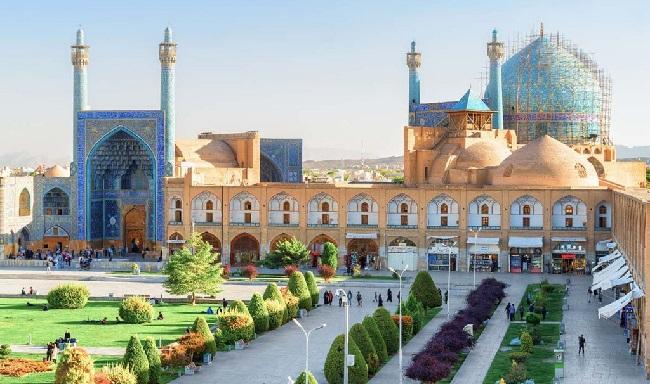Iran, known for its intricate architecture, ancient history, and warm hospitality, offers a travel experience like no other. From the poetic city of Shiraz to the bustling bazaars of Tehran, each destination provides a window into the soul of this fascinating country.

Top 10 Most Visited Places in Iran
1. Persepolis
Overview
Persepolis is the ancient ceremonial capital of the Achaemenid Empire, with magnificent ruins that speak volumes of its former glory.
Why Visit?
Explore the grand palaces, the imposing Gate of All Nations, and the intricate bas-reliefs that depict the empire’s history.
2. Isfahan
Overview
Isfahan, once the capital of Persia, is famous for its Persian-Islamic architecture, with grand boulevards, covered bridges, palaces, mosques, and minarets.
Why Visit?
Admire the stunning Naqsh-e Jahan Square, visit the Shah and Sheikh Lotfollah Mosques, and stroll along the Zayandeh River.
3. Shiraz
Overview
Shiraz is known as the city of poets, literature, wine, and flowers, with a history dating back over two thousand years.
Why Visit?
Visit the tombs of famous poets Hafez and Saadi, explore the elegant Nasir al-Mulk Mosque, and wander through the Eram Garden.
4. Tehran
Overview
Tehran, the dynamic capital of Iran, offers a mix of modernity and tradition, with bustling markets, museums, and parks.
Why Visit?
Explore the Golestan Palace, shop in the Grand Bazaar, and view the crown jewels at the National Jewelry Museum.
5. Tabriz Historic Bazaar Complex
Overview
Tabriz Bazaar, a UNESCO World Heritage site, is one of the oldest and largest bazaars in the Middle East, famously mentioned in the Silk Road route.
Why Visit?
Immerse yourself in the bustling atmosphere, shop for traditional Persian rugs, and explore the intricate maze of shops and caravanserais.
6. Yazd
Overview
Yazd is a desert city known for its unique Persian architecture of windcatchers and mud-brick homes, as well as its Zoroastrian heritage.
Why Visit?
Discover the ancient Fire Temple, wander through the atmospheric lanes, and see the impressive Towers of Silence.
7. Kashan
Overview
Kashan is an oasis city with a history that dates back to the early Neolithic age, known for its traditional houses and beautiful gardens.
Why Visit?
Tour the historical houses like Tabatabaei and Borujerdi, and relax in the tranquil Fin Garden.
8. Pasargadae
Overview
Pasargadae was the capital of the Achaemenid Empire under Cyrus the Great and is home to his impressive, albeit modest, tomb.
Why Visit?
Explore the ancient ruins that include palaces, gardens, and the still-standing Tomb of Cyrus the Great.
9. Qeshm Island
Overview
Qeshm is the largest island in the Persian Gulf, known for its natural wonders, such as the Valley of Stars and the Chahkooh Canyon.
Why Visit?
Experience the island’s geopark, spot dolphins off the coast, and learn about the local culture and traditions.
10. Kerman
Overview
Kerman is a historical city that serves as a trading hub with a rich legacy of craftsmanship, particularly famous for its hand-woven carpets.
Why Visit?
Visit the Ganjali Khan Complex, explore the local bazaars, and venture to the nearby Kaluts in the Lut Desert for a dramatic desert landscape.
In Summary
These six additional destinations offer a further glimpse into Iran’s multifaceted allure. From the ancient markets to the serene islands and desert cities, Iran’s landscapes are as varied as they are captivating, each place with its own unique story and beauty to discover.
FAQ: Top 10 Most Visited Places in Iran
Q1: Do I need a visa to travel to Iran?
A1: Most nationalities require a visa to enter Iran. Visa on arrival is available for tourists at certain airports, but it’s recommended to obtain a visa in advance. Check with the nearest Iranian embassy for the most current visa information.
Q2: What is the best time of year to visit Iran?
A2: The best time to visit Iran is during the spring (March to May) and autumn (September to November) when the weather is mild and pleasant. Summers can be very hot, especially in desert areas, and winters can be quite cold in the north.
Q3: What currency is used in Iran, and can I use my credit cards?
A3: The currency of Iran is the Iranian Rial (IRR). Due to international sanctions, credit cards are not accepted in Iran, and it’s necessary to bring cash for the duration of your stay. Euros or US dollars are the easiest to exchange.
Q4: Is it safe to travel to Iran?
A4: Iran is generally safe for travelers, with low crime rates compared to other countries. However, it’s always important to stay updated with your country’s travel advisories and respect local laws and customs during your visit.
Q5: Can I drink tap water in Iran?
A5: Tap water in major cities and towns is usually safe to drink, but it’s advisable to drink bottled water or purify your water in rural and remote areas.
Q6: What language is spoken in Iran?
A6: The official language is Persian, also known as Farsi. English is understood to some degree by many Iranians, especially the youth and those working in the tourism sector.
Q7: What should I wear when visiting Iran?
A7: Iran has conservative dress codes. Women are required to wear a headscarf and cover their arms and legs. Men should wear long pants and avoid sleeveless shirts. It’s recommended to dress modestly and respect Islamic customs.
Q8: What electrical plug type does Iran use?
A8: Iran uses the European-style Type C and Type F electrical outlets, with a standard voltage of 220V and a frequency of 50Hz.
Q9: What are some must-try dishes in Iran?
A9: Traditional Iranian dishes you should try include chelo kabab (rice and kebab), ghormeh sabzi (herb stew), fesenjan (pomegranate walnut stew), and for dessert, try faludeh or Persian ice cream.
Q10: Can I use my phone in Iran?
A10: Foreign phones must be registered upon arrival in Iran to work with a local SIM card. It’s possible to purchase a local SIM card at the airport or from shops in major cities.


















































